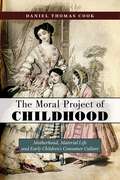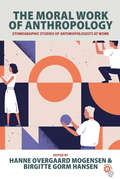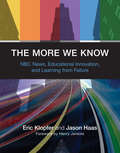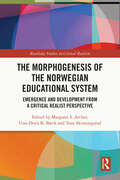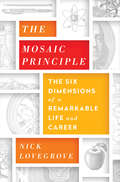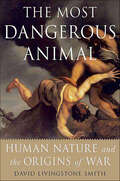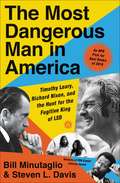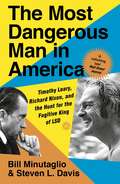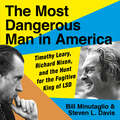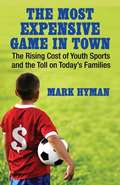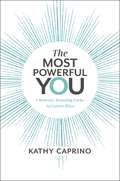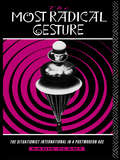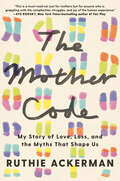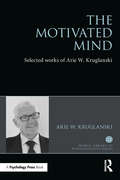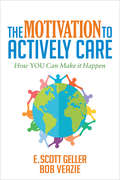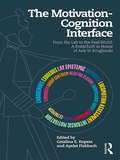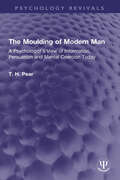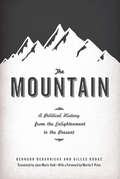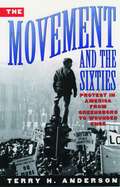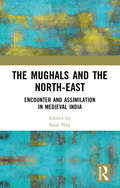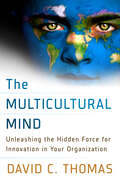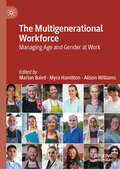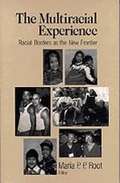- Table View
- List View
The Moral Project of Childhood: Motherhood, Material Life, and Early Children's Consumer Culture
by Daniel Thomas CookExamines the Protestant origins of motherhood and the child consumer Throughout history, the responsibility for children’s moral well-being has fallen into the laps of mothers. In The Moral Project of Childhood, the noted childhood studies scholar Daniel Thomas Cook illustrates how mothers in the nineteenth-century United States meticulously managed their children’s needs and wants, pleasures and pains, through the material world so as to produce the “child” as a moral project. Drawing on a century of religiously-oriented child care advice in women’s periodicals, he examines how children ultimately came to be understood by mothers—and later, by commercial actors—as consumers. From concerns about taste, to forms of discipline and punishment, to play and toys, Cook delves into the social politics of motherhood, historical anxieties about childhood, and early children’s consumer culture. An engaging read, The Moral Project of Childhood provides a rich cultural history of childhood.
The Moral Work of Anthropology: Ethnographic Studies of Anthropologists at Work (Anthropology at Work #2)
by Hanne Overgaard Mogensen Birgitte Gorm HansenLooking at anthropologists at work, this book investigates what kind of morality they perform in their occupations and what the impact of this morality is. The book includes ethnographic studies in four professional arenas: health care, business, management and interdisciplinary research. The discussion is positioned at the intersection of ‘applied or public anthropology’ and ‘the anthropology of ethics’ and analyses the ways in which anthropologists can carry out ‘moral work’ both inside and outside of academia.
The Moral Work of Anthropology: Ethnographic Studies of Anthropologists at Work (Anthropology at Work #2)
by Hanne Overgaard Mogensen Birgitte Gorm HansenLooking at anthropologists at work, this book investigates what kind of morality they perform in their occupations and what the impact of this morality is. The book includes ethnographic studies in four professional arenas: health care, business, management and interdisciplinary research. The discussion is positioned at the intersection of ‘applied or public anthropology’ and ‘the anthropology of ethics’ and analyses the ways in which anthropologists can carry out ‘moral work’ both inside and outside of academia.
The More We Know: NBC News, Educational Innovation, and Learning from Failure
by Eric Klopfer Jason HaasThe rise and fall of iCue: lessons about new media, old media, and education from an NBC-MIT joint venture into interactive learning.In 2006, young people were flocking to MySpace, discovering the joys of watching videos of cute animals on YouTube, and playing online games. Not many of them were watching network news on television; they got most of their information online. So when NBC and MIT launched iCue, an interactive learning venture that combined social networking, online video, and gaming in one multimedia educational site, it was perfectly in tune with the times. iCue was a surefire way for NBC to reach younger viewers and for MIT to test innovative educational methods in the real world. But iCue was a failure: it never developed an audience and was canceled as if it were a sitcom with bad ratings. In The More We Know, Eric Klopfer and Jason Haas, both part of the MIT development team, describe the rise and fall of iCue and what it can teach us about new media, old media, education, and the challenges of innovating in educational media.Klopfer and Haas show that iCue was hampered by, among other things, an educational establishment focused on “teaching to the test,” television producers uncomfortable with participatory media, and confusion about the market. But this is not just a cautionary tale; sometimes more can be learned from an interesting failure than a string of successes. Today's educational technology visionaries (iPads for everyone!) might keep this lesson in mind.
The Morphogenesis of the Norwegian Educational System: Emergence and Development from a Critical Realist Perspective (Routledge Studies in Critical Realism)
by Margaret S. ArcherBased in the philosophy of critical realism, this book employs a range of Margaret Archer’s theoretical concepts to investigate temporal and spatial aspects of Norwegian education. Stemming from Archer’s engagement as visiting professor from 2017 to 2019 in the Department of Education at UiT The Arctic University of Norway, the book explores a new area for critical realist theorizing by asking how different spatial contexts affect the workings of the system. The various chapters employ diverse sets of Archer’s theoretical concepts; from morphogenetic cycles and the emergence of educational systems at the macro level, to the exercise of reflexivity among individual school leaders and students at the micro level. In contrast to the focus on educational homogeneity and similarity among Nordic and Scandinavian countries, and promotion of the conception of the ‘Nordic Model’, this book draws attention to differences between these nations as well as regional differences within Norway. As such, it will appeal to scholars with interests in education, sociology, critical realism, educational sciences and pedagogy, education history and political science as well those with a specific interest in the Nordic region.
The Mortality and Morality of Nations
by Uriel AbulofStanding at the edge of life's abyss, we seek meaningful order. We commonly find this 'symbolic immortality' in religion, civilization, state and nation. What happens, however, when the nation itself appears mortal? The Mortality and Morality of Nations seeks to answer this question, theoretically and empirically. It argues that mortality makes morality, and right makes might; the nation's sense of a looming abyss informs its quest for a higher moral ground, which, if reached, can bolster its vitality. The book investigates nationalism's promise of moral immortality and its limitations via three case studies: French Canadians, Israeli Jews, and Afrikaners. All three have been insecure about the validity of their identity or the viability of their polity, or both. They have sought partial redress in existential self-legitimation: by the nation, of the nation and for the nation's very existence.
The Mosaic Principle: The Six Dimensions of a Remarkable Life and Career
by Nick LovegroveLife-personally and professionally-is lived to the fullest as a mosaic, encompassing a rich and complex set of diverse experiences that provide purpose, meaning, happiness, and success.Yet, the pressures of modern society push us toward narrower focus and deeper specialization in our lives and careers. Our pursuit of specific expertise risks us becoming isolated from those different from us; our lack of shared experience fosters suspicion and conflict. Today we have businesspeople and government officials who persistently distrust and demonize each other; a fortunate swath of society with professional and financial security, increasingly isolated from those left behind; and community leaders who struggle to relate to and connect with the communities they serve. In every walk of life we have allowed ourselves to be pushed into self-defining cocoons from which it is difficult to break out.Nick Lovegrove's compelling vision provides the way out of this contemporary trap. He supplies vivid portraits of those who get it right (such as Paul Farmer, the physician whose broad and imaginative choices bring health and hope to the world's poorest people) and those who get it deeply wrong (such as Jeffrey Skilling, the former CEO of Enron) and connects their experiences with a blueprint of six skills-a moral compass, transferrable skills, contextual intelligence, prepared mind, intellectual thread, and extended network. The Mosaic Principle will help you to succeed in an ever-changing, more complex, and diverse world, and build a more remarkable and fulfilling life.
The Most Dangerous Animal: Human Nature and the Origins of War
by David Livingstone Smith“Original and compelling insights into the human capacity for war . . . A must read for anyone interested in the psychological depths of human nature.” —Barbara S. Held, author of Back to RealityAlmost 200 million human beings, mostly civilians, have died in wars over the last century, and there is no end of slaughter in sight.The Most Dangerous Animal asks what it is about human nature that makes it possible for human beings to regularly slaughter their own kind. It tells the story of why all human beings have the potential to be hideously cruel and destructive to one another. Why are we our own worst enemy? The book shows us that war has been with us—in one form or another—since prehistoric times, and looking at the behavior of our close relatives, the chimpanzees, it argues that a penchant for group violence has been bred into us over millions of years of biological evolution. The Most Dangerous Animal takes the reader on a journey through evolution, history, anthropology, and psychology, showing how and why the human mind has a dual nature: on the one hand, we are ferocious, dangerous animals who regularly commit terrible atrocities against our own kind, on the other, we have a deep aversion to killing, a horror of taking human life.Meticulously researched and far-reaching in scope and with examples taken from ancient and modern history, The Most Dangerous Animal delivers a sobering lesson for an increasingly dangerous world.“Illuminates an exceedingly dark subject: humankind’s deep-seated penchant for war. The result is a discerning, insightful, highly original, and very disturbing book.” —Andrew J. Bacevich, author of The Age of Illusions
The Most Dangerous Man in America: Timothy Leary, Richard Nixon and the Hunt for the Fugitive King of LSD
by Bill Minutaglio Steven L. DavisFrom Bill Minutaglio and Steven L. Davis, authors of the PEN Center USA award-winning Dallas 1963, comes a madcap narrative about Timothy Leary's daring prison escape and run from the law.On the moonlit evening of September 12, 1970, an ex-Harvard professor with a genius I.Q. studies a twelve-foot high fence topped with barbed wire. A few months earlier, Dr. Timothy Leary, the High Priest of LSD, had been running a gleeful campaign for California governor against Ronald Reagan. Now, Leary is six months into a ten-year prison sentence for the crime of possessing two marijuana cigarettes.Aided by the radical Weather Underground, Leary's escape from prison is the counterculture's union of "dope and dynamite," aimed at sparking a revolution and overthrowing the government. Inside the Oval Office, President Richard Nixon drinks his way through sleepless nights as he expands the war in Vietnam and plots to unleash the United States government against his ever-expanding list of domestic enemies. Antiwar demonstrators are massing by the tens of thousands; homemade bombs are exploding everywhere; Black Panther leaders are threatening to burn down the White House; and all the while Nixon obsesses over tracking down Timothy Leary, whom he has branded "the most dangerous man in America."Based on freshly uncovered primary sources and new firsthand interviews, THE MOST DANGEROUS MAN IN AMERICA is an American thriller that takes readers along for the gonzo ride of a lifetime. Spanning twenty-eight months, President Nixon's careening, global manhunt for Dr. Timothy Leary winds its way among homegrown radicals, European aristocrats, a Black Panther outpost in Algeria, an international arms dealer, hash-smuggling hippies from the Brotherhood of Eternal Love, and secret agents on four continents, culminating in one of the trippiest journeys through the American counterculture.
The Most Dangerous Man in America: Timothy Leary, Richard Nixon and the Hunt for the Fugitive King of LSD
by Bill Minutaglio Steven L. Davis'It's a rollicking tale that brings to life the antic atmosphere of America in the 'Me' Decade' Wall Street Journal'A madcap chase... this is a well-written chronicle of 28 months when the world went slightly mad' Sunday Times'A suitably head-spinning account of LSD High Priest Dr Timothy Leary' Mail on SundayOn the moonlit evening of September 12, 1970, an ex-Harvard professor with a genius IQ studies a twelve-foot high fence topped with barbed wire. A few months earlier, Dr. Timothy Leary, the High Priest of LSD, had been running a gleeful campaign for California governor against Ronald Reagan. Now, Leary is six months into a ten-year prison sentence for the crime of possessing two marijuana cigarettes.Aided by the radical Weather Underground, Leary's escape from prison is the counterculture's union of "dope and dynamite," aimed at sparking a revolution and overthrowing the government. Inside the Oval Office, President Richard Nixon drinks his way through sleepless nights as he expands the war in Vietnam and plots to unleash the United States government against his ever-expanding list of domestic enemies. Antiwar demonstrators are massing by the tens of thousands; homemade bombs are exploding everywhere; Black Panther leaders are threatening to burn down the White House; and all the while Nixon obsesses over tracking down Timothy Leary, whom he has branded "the most dangerous man in America."Based on freshly uncovered primary sources and new firsthand interviews, THE MOST DANGEROUS MAN IN AMERICA is an American thriller that takes readers along for the gonzo ride of a lifetime. Spanning twenty-eight months, President Nixon's careening, global manhunt for Dr. Timothy Leary winds its way among homegrown radicals, European aristocrats, a Black Panther outpost in Algeria, an international arms dealer, hash-smuggling hippies from the Brotherhood of Eternal Love, and secret agents on four continents, culminating in one of the trippiest journeys through the American counterculture.
The Most Dangerous Man in America: Timothy Leary, Richard Nixon and the Hunt for the Fugitive King of LSD
by Bill Minutaglio Steven L. Davis'It's a rollicking tale that brings to life the antic atmosphere of America in the 'Me' Decade' Wall Street Journal'A madcap chase... this is a well-written chronicle of 28 months when the world went slightly mad' Sunday TimesFrom Bill Minutaglio and Steven L. Davis, authors of the PEN Center USA award-winning Dallas 1963, comes a madcap narrative about Timothy Leary's daring prison escape and run from the law.On the moonlit evening of September 12, 1970, an ex-Harvard professor with a genius IQ studies a twelve-foot high fence topped with barbed wire. A few months earlier, Dr. Timothy Leary, the High Priest of LSD, had been running a gleeful campaign for California governor against Ronald Reagan. Now, Leary is six months into a ten-year prison sentence for the crime of possessing two marijuana cigarettes.Aided by the radical Weather Underground, Leary's escape from prison is the counterculture's union of "dope and dynamite," aimed at sparking a revolution and overthrowing the government. Inside the Oval Office, President Richard Nixon drinks his way through sleepless nights as he expands the war in Vietnam and plots to unleash the United States government against his ever-expanding list of domestic enemies. Antiwar demonstrators are massing by the tens of thousands; homemade bombs are exploding everywhere; Black Panther leaders are threatening to burn down the White House; and all the while Nixon obsesses over tracking down Timothy Leary, whom he has branded "the most dangerous man in America."Based on freshly uncovered primary sources and new firsthand interviews, THE MOST DANGEROUS MAN IN AMERICA is an American thriller that takes readers along for the gonzo ride of a lifetime. Spanning twenty-eight months, President Nixon's careening, global manhunt for Dr. Timothy Leary winds its way among homegrown radicals, European aristocrats, a Black Panther outpost in Algeria, an international arms dealer, hash-smuggling hippies from the Brotherhood of Eternal Love, and secret agents on four continents, culminating in one of the trippiest journeys through the American counterculture.(P)2018 Hachette Audio
The Most Expensive Game in Town
by Mark HymanNearly 50 million kids play organized sports each year, and each of them has a supportive family that digs deep into its pockets to pay for the essentials-uniforms, equipment, league fees, travel to away games. But the buck doesn’t stop there. With private lessons, elite sports camps, corporate-sponsored tournaments, and all the hotel expenses and tourist traps that come with them, youth sports is more than just a fun pastime. It’s an incredibly profitable market, and it’s become crowded with companies and individuals eager to reap the rewards. Building on his eye-opening investigation into the damaging effects of the ultra-competitive culture of youth sports in his first book,Until It Hurts, sports dad and journalist Mark Hyman takes us behind the scenes for a startling look at the business of youth sports, how it has changed, and how it is affecting young Americans. Examining the youth sports economy from many sides-the major corporations, small entrepreneurs, coaches, parents, and, of course, kids-Hyman probes the reasons for rapid changes in what gets bought and sold in this lucrative marketplace. He takes us to tournaments sponsored by Nike, Gatorade, and other big businesses. He talks to parents who sacrifice their vacations and savings to get their (sometimes reluctant) junior stars to these far-off, expensive venues for a chance to shine. And he introduces us to videos purporting to teach six-month-old babies to kick a ball, to professional athletes who will “coach” an eight-year-old for a hefty fee, to a town that has literally staked its future on preteen sports. However, the story isn’t all big business and bad guys. Hyman also turns the spotlight on individuals cashing in on the youth sports market, but whose goods actually provide (at least) some benefits to kids. Through extensive interviews and original reporting,The Most Expensive Game in Townlooks beyond the high-energy ad campaigns, the supposedly performance-enhancing sneakers, and the cute baby-sized jerseys to explain the causes and effects of the commercialization of youth sports-and to reveal how these changes are distorting and diminishing family life. The proof is in the price tag. Happily, Hyman unearths promising examples of individuals and communities bucking this destructive trend and using youth sports to uplift and enrich kids’ lives, rather than to fill their own pockets.
The Most Powerful You: 7 Bravery-Boosting Paths to Career Bliss
by Kathy CaprinoKathy Caprino guides women to take the reins in their careers by identifying and overcoming the seven most damaging power gaps holding them back from the success they want and deserve.The business world has been forever changed by the important progress and contributions that women have made. Yet, with only 38% of manager roles and 22% of C-suite positions being held by women, women continue to struggle to achieve the reward, respect, and authority they have earned.In these pages, career, executive and leadership coach Kathy Caprino helps women conquer the seven destructive power gaps within the workforce, outline the key steps you can take to access greater positive power, and become the true author of your life.Through riveting real-life success stories of women overcoming these gaps, and proven strategies and solutions from more than 30 of the nation&’s top experts in fields that are essential to women&’s success, the exercises in The Most Powerful You will equip you with the strength to:See yourself more powerfully (Brave Sight)Speak more confidently (Brave Speak)Ask for and receive what you deserve (Brave Ask)Connect to your advantage with influential support (Brave Connection)Challenge and change negative behavior toward you (Brave Challenge)Be of service in more meaningful ways (Brave Service)Heal from past trauma and challenge (Brave Healing) Most importantly, The Most Powerful You will reconnect you to the thrilling dreams you once had for your life and empower you to take the necessary steps to reclaim that dream while making your positive impact in the world.
The Most Radical Gesture: The Situationist International in a Postmodern Age
by Sadie PlantThis book is the first major study of the Situationist International. Tracing the history, ideas and influences of this radical and inspiring movement from dada to postmodernism, it argues that situationist ideas of art, revolution, everyday life and the spectacle continue to inform a variety of the most urgent poltical events, cultural movements, and theoretical debates of our times.
The Mother Code: My Story of Love, Loss, and the Myths That Shape Us
by Ruthie AckermanIn this propulsive memoir, an award-winning journalist blends history, science, and cultural criticism to uncover whether motherhood outside of society&’s rigid rules and expectations is possible—and whether she fits the mold for what a mother should be.&“This tender, generous book does the hard work of redefining &‘motherhood&’ and &‘family&’ so that they honor all aspects of a woman&’s life.&”—Christie Tate, author of the New York Times bestseller GroupRuthie Ackerman had long believed that the decision to not have children was a radical act. She&’d grown up being told that she came from a long line of women who had abandoned their kids and feared she would pass on her half-brother&’s rare genetic disorder. So when she marries a man who doesn&’t want children, she hopes she can be happy without any. But a voice in her head keeps returning to the question: What if mothering can be a radical act too? When her marriage veers off course, she goes searching through the twists and turns of her DNA to decide once and for all whether she should become a mother.By the time Ruthie finally determines that she desperately wants a child, she learns that motherhood won&’t happen the way she thought it would. Now she must enter the hall of mirrors where biology, genetics, and philosophy collide as she wonders what it means to both create and nurture a life. What does inheritance really entail? What does it mean to be a &“good&” mother? When it comes down to it, how important is nature versus nurture? And where are the models for what a &“good life&” can look like for women, both with and without children?Synthesizing reportage and memoir, The Mother Code unravels how we&’ve come to understand the institution of motherhood. What emerges is a groundbreaking new vision for what it means to parent: a mother code that goes beyond our bloodlines and genetics and instead urges us to embrace inheritance as the legacy we want to leave behind for those we love.
The Motivated Mind: The Selected Works of Arie Kruglanski (World Library of Psychologists)
by Arie Professor KruglanskiIn the World Library of Psychologists series, international experts themselves present career-long collections of what they judge to be their finest pieces - extracts from books, key articles, salient research findings, and their major practical theoretical contributions. In this volume Arie Kruglanski reflects on the development throughout his distinguished career of his wide-ranging research covering radicalisation, human judgement and belief formation, group and intergroup processes, and motivated cognition. This collection offers an invaluable insight into the key works behind the formation of Kruglanski’s seminal theory of lay epistemics, as well as his important input into a diverse range of fields of social psychology. A specially written introduction gives an intimate overview of this career, and contextualises the selection in relation to changes in the field during this time. With continuing relevance today, and of vast historical importance, this collection is essential reading for anyone with an interest in goals, belief formation, group processes, and social psychology in general.
The Motivation to Actively Care: How You Can Make it Happen
by E. Scott Geller Bob VeazieThis refreshing teaching/learning narrative, based on actual life events and research-supported principles, begins with the lead character (Joanne Cruse) losing her job as the Safety Director for a large manufacturing company. Subsequently, her former psychology professor, Dr. Pitz ("Doc"), invites her to try out for a position as leadership consultant with his firm, Make-A-Difference, Inc. (MAD) that helps companies cultivate a self-motivated and personally-engaged workforce. Throughout her probationary period, Joanne travels with the top consultant at MAD (Mickey Vasquez) to visit a number of organizations struggling with various occupational issues related to the human dynamics of self-motivation (i.e., working to accomplish an organization's milestone from a self-directed or self-accountability mindset). The interpersonal and group interactions Joanne experiences at diverse organizations, accompanied by Mickey’s professional coaching, reveal twenty practical and profound leadership lessons to nurture an actively caring for people work culture in which employees put forth their best efforts on behalf of their company's mission.
The Motivation-Cognition Interface: From the Lab to the Real World: A Festschrift in Honor of Arie W. Kruglanski
by Catalina E. Kopetz Ayelet FishbachThis volume honors the work of Arie W. Kruglanski. It represents a collection of chapters written by Arie’s former students, friends, and collaborators. The chapters are rather diverse and cover a variety of topics from politics, including international terrorism, to health related issues, such as addiction and self-control, to basic psychological principles, such as motivation and self-regulation, the formation of attitudes, social influence, and interpersonal relationships. What these chapters have in common is that they have all been inspired by Arie’s revolutionary work on human motivation and represent the authors’ attempt to apply the basic principles of motivation to the understanding of diverse phenomena.
The Moulding of Modern Man: A Psychologist's View of Information, Persuasion and Mental Coercion Today (Psychology Revivals)
by T. H. PearFirst published in 1961, The Moulding of Modern Man discusses views of the nature and boundaries of the Self, its relation to the physical world and to human beings, real and imagined, with reference to procedures training ‘space men’ to travel alone or in company, deprived of the assurances of sight, sound, even weight. It discusses methods of publicity and advertising, of overtly or covertly influencing motives, subception or subliminal persuasion and techniques of ‘thought reform’ often vaguely termed character training, and, more confusingly, ‘brain-washing’. Other topical subjects are conflicting loyalties, with special reference to the moral problems of scientists; the social significance in different countries of intellectuals and anti-intellectuals; the effects of mass culture upon the individual’s beliefs, tastes and opinions; the role of the Organization Man in Britain; the concepts of ‘face’ and ‘prestige’ in groups and nations; and conflicting ideas of progress maintained by contemporary thinkers in ‘two cultures’. This book will be of interest to students of philosophy and psychology.
The Mountain: A Political History from the Enlightenment to the Present
by Bernard Debarbieux Gilles RudazIn The Mountain, geographers Bernard Debarbieux and Gilles Rudaz trace the origins of the very concept of a mountain, showing how it is not a mere geographic feature but ultimately an idea, one that has evolved over time, influenced by changes in political climates and cultural attitudes. To truly understand mountains, they argue, we must view them not only as material realities but as social constructs, ones that can mean radically different things to different people in different settings. From the Enlightenment to the present day, and using a variety of case studies from all the continents, the authors show us how our ideas of and about mountains have changed with the times and how a wide range of policies, from border delineation to forestry as well as nature protection and social programs, have been shaped according to them. A rich hybrid analysis of geography, history, culture, and politics, the book promises to forever change the way we look at mountains.
The Movement and the Sixties
by Terry AndersonA searching history of the social activism that defined a generation of young Americans and that called into question the very nature of "America."
The Mughals and the North-East: Encounter and Assimilation in Medieval India
by Sajal NagThere is a perception that the region of north-east India maintained its ‘splendid isolation’ and remained outside the reach of the Mughals and did not have a pre-colonial past. The present book is an attempt to decenter and demolish the said perceptions and asserts that north-east India had a ‘medieval’ past through linkage with the dominant central power in India – the Mughals. The eastern frontier of this Mughal Empire was constituted by a number of states like Bengal, Koch Bihar, Assam, Manipur, Dimasa, Jaintia, Cachar, Tripura, Khasi confederation, Chittagong, Lushai and the Nagas. Of these, some areas like Bengal were an integral part of the Mughal Empire, while others like Koch Bihar and Assam were in and out of the empire. Tripura, Manipur, Jaintia and Cachar were frequently overrun by the Mughals whenever the State was short of revenue and withdrew soon without incorporating them in the state. Despite not being a formal part of the Mughal Empire, the society, economy, polity and culture of the north-east India, however, had been majorly impacted by the Mughal presence. The brief, but effective advent of the Mughals had supplanted certain political and revenue institutions in various states. It generated trade and commerce, which linked it to the rest of India. A number of wondering Sufi saints, Islamic missionaries, imprisoned Mughal soldiers and officers were settled in various states, which resulted in a substantial Muslim population growth in the region. Besides the population, there are numerous Islamic and syncretic institutions, cultures, and shrines which dot the entire region.
The Multicultural Mind: Unleashing the Hidden Force for Innovation in Your Organization
by David ThomasGlobalization has created a superheated competitive business environment that demands innovation to stay ahead. But it's also created a hidden source of innovation right in your midst: the people in your organization who have deep experience in more than one culture—multiculturals. Having to integrate different cultural frameworks has enabled them to develop abilities that can contribute powerfully to building innovative organizations. David Thomas makes a compelling business case for recognizing and cultivating a new dimension of diversity—the diversity within individuals! He looks at how to establish the organizational conditions under which multiculturals can flourish and shows how even the most monocultural among us can gain the advantages of a multicultural mind.
The Multigenerational Workforce: Managing Age and Gender at Work
by Myra Hamilton Alison Williams Marian BairdThis book provides original and groundbreaking insights into the development and outcomes of multigenerational workforce strategies in Australian workplaces through the combined lens of age, gender and caring. Based on a large-scale study and real-world case studies with six Australian organisations, it highlights leading policies and practices that promote successful ageing at work, identifies optimal work designs for older workers’ participation, engagement and wellbeing at work, and offers strategies to support workers to combine work and unpaid care at different times in their lives. The book offers essential guidance for those undertaking research on multigenerational workforces, and for managers, human resource staff, diversity and inclusion staff, and other practitioners in organisations seeking to deepen their understanding of age- and gender-inclusive workforce policies and practices in the context of ageing populations and workforces.
The Multiracial Experience: Racial Borders as the New Frontier
by Maria P. P. RootFor the first time in US history, according to the Census Bureau, the number of biracial babies is increasing at a faster rate than the number of single-race babies. In this collection educators, philosophers, sociologists, social workers, and others consider personal experience and theory as well as practical ideas for incorporating mutltiracial thinking into areas such as education, gender issues, and census forms. The 24 essays are divided into six sections: human rights; identity; blending and flexibility; gender and sexual identity; multicultural education; and the new millennium.
